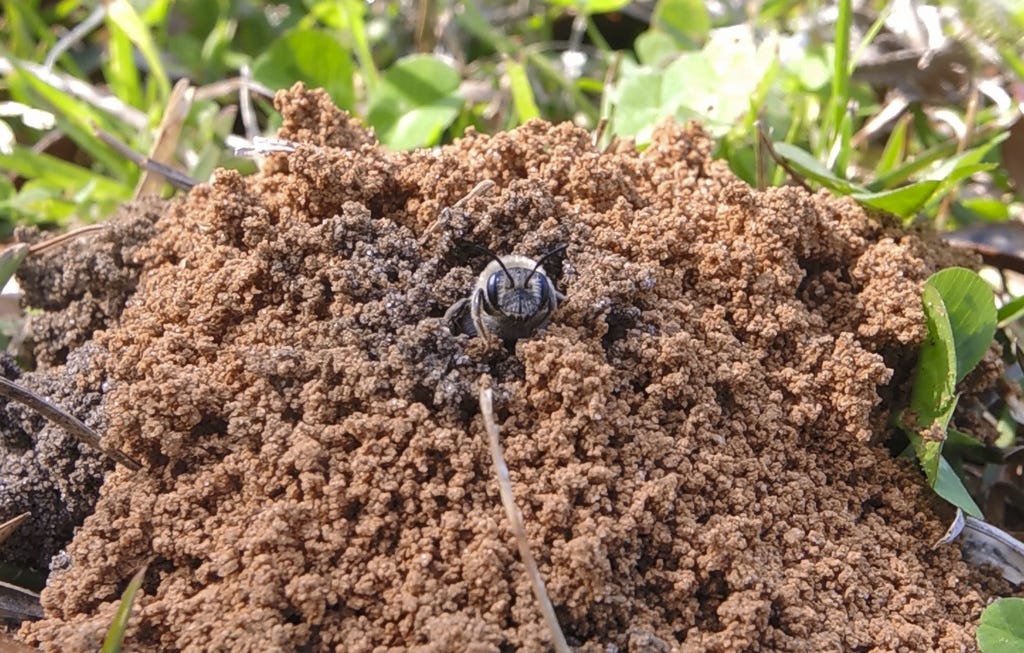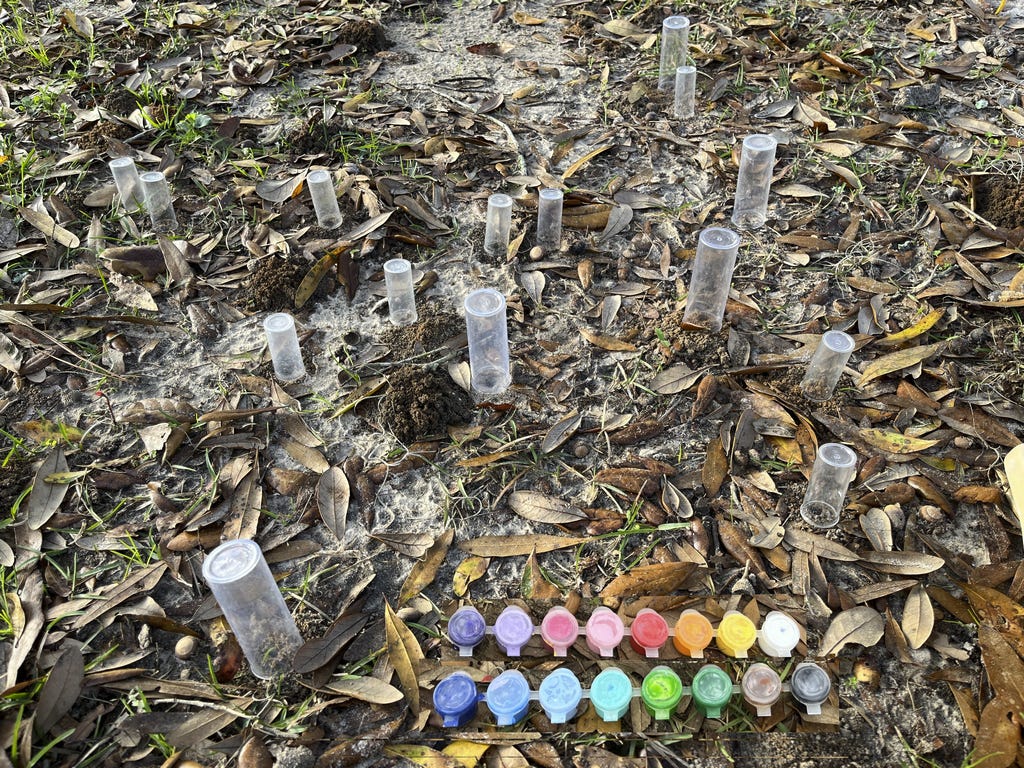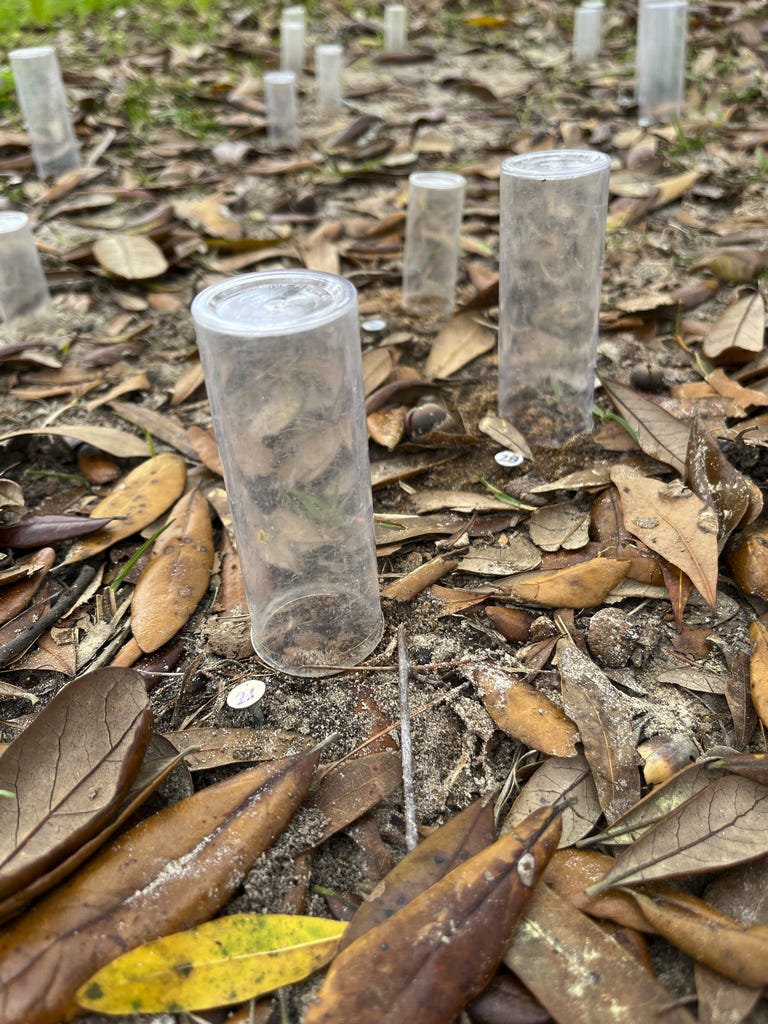
Back in September of 2024, I posted an essay entitled, Deep in the Mines of Bees in which I described the spectacular, month-long emergence of over 22,000 nests of Andrena miner bees in a park in Tallahassee in the previous March. Emerging bees made mounds of excavated soil, collected pollen and nectar to stock the cells at the bottom of their nests for their offspring (that would emerge the following March). I made zinc casts that showed the nests to be almost a meter deep, and that most of this depth was not dug by the current occupant, but was probably inherited from the parent(s).
This inevitably led to questions, because multiple bees developed in the brood cells at the bottom of each nest. First question: who gets the natal nest as their own next March? There will almost certainly be sisters, so do sister bees share the nest, and if so, do they cooperate in rearing the next generation? Or is all but one sister just out of luck? You can see where I was going at the end of the bee season in March 2024.
A year later in early March 2025, I revisited this population shortly after they began their month-long activity. Unfortunately, I could only get in 5 or 6 days of observations because we were leaving town. My main question was, do multiple bees use each nest? If yes, it suggests that they may be sisters. Second, are bees faithful to a single nest, returning to it trip after trip? Both of these questions can be answered by marking bees as they emerge from the nest, then observing whether they return to the same nest and whether or not additional bees leave or enter the nest.

Capturing bees for marking was simple. I positioned a plastic tube over each nest opening and waited until a bee was buzzing around in the tube. Holding the bee with forceps, I then dabbed her thorax and abdomen with spots of tempera paint. With two colors, I could generate a large number of unique combinations. There was an average of 30 nest openings per square meter, and I couldn’t be sure of each nest identity, so I tagged 33 of them with tiny numbered tags (roofing nails). I hoped they would not serve as landmarks for the returning bee.

I am not a “get-up-at-dawn” sort of person, so I got to the the population after the first wave of foragers had left (probably around 9 a.m.). Beginning about 11 a.m., there was thus a mid-day wave of returning foragers, yellow with pollen, with legs like yellow drumsticks, each seeking out and entering a nest. The laws of probability dictated that only a few of them entered my 33 marked nests. Several times, bees briefly entered a nest then left again, suggesting that searches at very close range may be partly trial and error. Considering the density of nests, all of which look alike, it seems inevitable that there would be some errors.
Over four days of observations, 14 (40%) of these 33 nests were occupied by more than one bee (2-4 bees). In the remaining 19 nests, I only saw a single bee, but I couldn’t be sure that this meant single-occupancy because it was easy to miss the rapid entry of a forager bee.
A few more bits of data. I estimated the depth of 17 nests by pushing a 2 mm polyethylene tube down to the bottom, as you can see in this video. The average depth was 94 cm, i.e. about a meter.
By March 13, about two weeks into “the season”, about half the soil mounds had an open entrance, suggesting that half the nests were well into foraging, while the other half were still excavating cells. The average weight of soil topping burrows was 37 grams, pretty good for bees weighing about 100 mg (my guess), and about 400 times their own body weight. This soil weight translated into about 19 cubic centimeters of cells deep in the nest, enough to house a couple of dozen larvae if they took up most of each cell (which I do not know).
Several of the returning foragers entered nests other than the one they were marked from. In most cases, they stayed only briefly, then re-emerged and flew away. In one case, the “mistaken” forager emerged without the large pollen load she had entered with. This “wrong” nest was only a few centimeters from the “right” nest, suggesting that bees can make mistakes. But this thought is tempered by what “right” and “wrong” mean to a bee—- what if the “wrong” nest belonged to a close relative, or burrows could house roommates that didn’t necessarily cooperate in brood rearing? Am I seeing nascent sociality here? If these bees are sisters, do they specialize on different aspects of reproduction? If so, isn’t such division of labor a hallmark of sociality? Yet, andrenids are supposed to be solitary, non-social and all that. These questions probably push the limits of what I can answer with my limited means and time.
Like many scientific projects, this one raised a lot of interesting questions, questions that could keep me busy for years. For questions answerable with DNA (relatedness, inbreeding, etc.), I would need the collaboration of colleagues. Among questions that might be within my ability to answer: do bees use landmarks and visual cues as guides? Manipulating landmarks at various scales would be fun, yes? In the end, so many questions, so much fun, so much curiosity, so little time! What’s a poor boy supposed to do?

Fascinating! I hereby bestow on you the first ever Master of Substack Science degree M.S.S.), to add to all your others.
First, I love every one of your essays! Thank you! Second, where do you get numbered roofing nails I need something like that for my archaeology work.